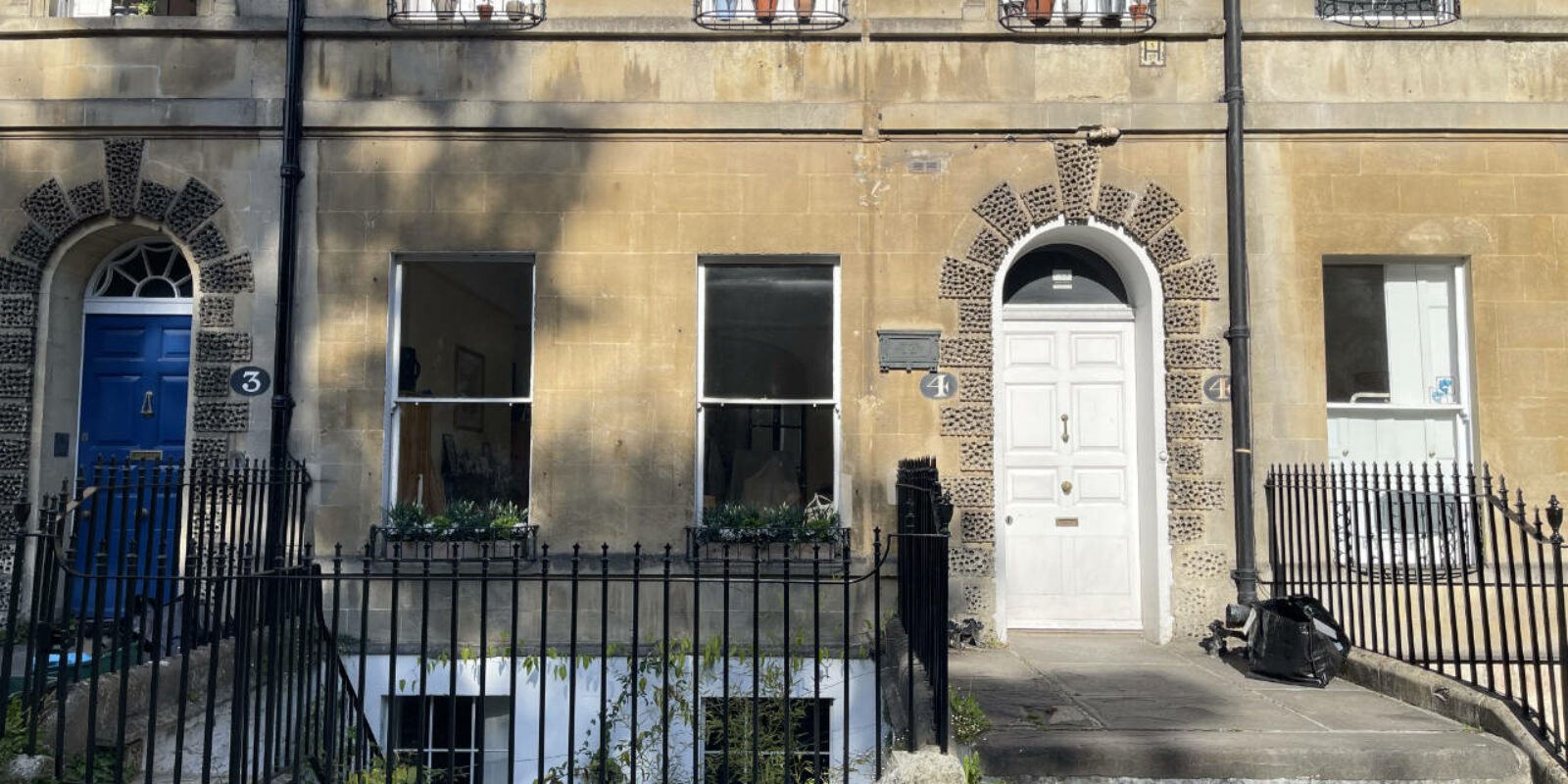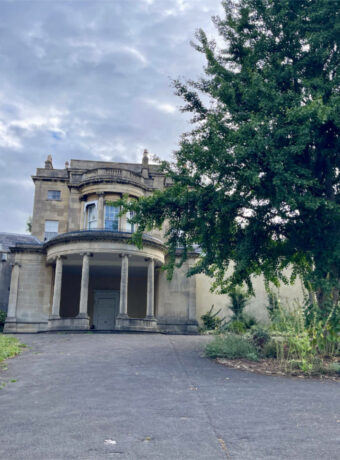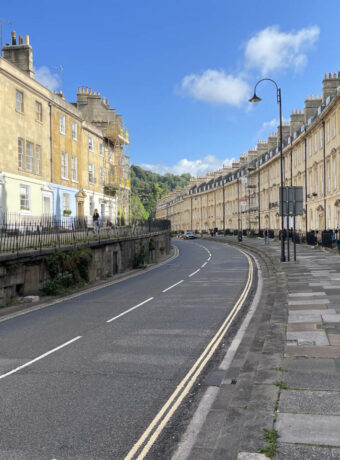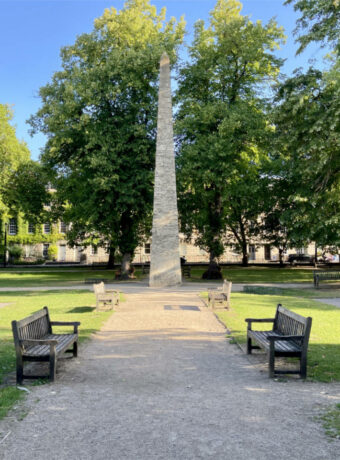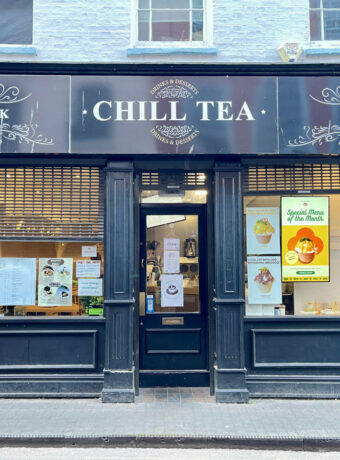All photos and images are copyright protected. Digital images and prints are available for purchase, please use the contact page or leave us a message below. All rights reserved
When Jane Austen moved into No. 4 Sydney Place in Bath in 1801, the city was bustling with new development and excitement. The Bathwick Estate was recently established, with imposing and elegant Georgian architecture and direct access to the newly opened Sydney Gardens, then known as Sydney Vauxhall Pleasure Gardens. Austen’s residence at Sydney Place placed her close to the heart of fashionable Bath society, directly opposite these popular gardens.
For Jane, who had spent most of her life in the Hampshire countryside, this move to a fashionable city represented both promise and uncertainty. Bath was, at the turn of the 19th century, the epicentre of genteel society in England. a place to be seen, to socialise, and for young women of good breeding to make advantageous matches.
The Austens, recently retired from parish life, sought a respectable position in this dynamic city. Their stay at Sydney Place would last until 1804 and leave a mark on Jane’s life and imagination. The city and its people would soon reappear in her novels with sparkling clarity, sharp wit and subtle critique.
Sydney Place was indeed a fashionable address at the time for even Queen Charlotte, consort of George III herself occupied a large house at the Eastern end of Sydney Place, although Jane predated her arrival in Bath by over a decade (1917).
Jane Austen’s Life at 4 Sydney Place 1801-1805
No. 4 Sydney Place was an impressive Georgian townhouse, spacious enough to comfortably accommodate the Austen family. Jane and her sister Cassandra shared a room on the second floor at the back of the house, which overlooked the fields and kitchen gardens that today make up the rest of the Pulteney Estate and Henrietta Gardens. It provided a quiet retreat from the busy social calendar of a young lady of the time.
The house itself was arranged in typical Georgian style, with a parlour on the ground floor where Jane, Cassandra and their mother would spend their time sewing, writing letters, and reading (often aloud to each other) to each other. The back room on the ground floor may likely have been Mr Austen’s study. On the first floor, the rooms were very likely the drawing and dining rooms where they would receive guests who came to call. These were often the largest rooms with high ceilings and impressive windows. On the second floor were the family’s bedrooms while the attic rooms housed the servant’s quarters.
During their time at Sydney Place, the Austens employed two servants, a manservant and a housekeeper/ladies maid. The layout of the house was practical for their needs: the front of the house faced the vibrant Sydney Vauxhall Gardens which although walled at the time, would have still been visible from the upper floors of the house,
Their neighbours especially along the Great Pulteney Street included notable residents of Bath society, offering the family ample opportunities for socialising and attending events within their immediate community. However, Austen’s own letters hint at a gentle, underlying critique of the somewhat artificial nature of these neighbourly interactions.
Jane’s Life at Sydney Place
Jane Austen was 25 years old when she moved with her family to Bath. The four years spent at No. 4 Sydney Place were socially active but personally and creatively quiet. While she was no longer an anonymous country girl, Bath offered every opportunity for introductions, balls, walks, and gatherings, this period was not a particularly productive one for her writing. Despite this, her time here proved observationally rich, with insights and impressions that would resurface later in her novels.
Jane wrote to her sister often about the walks (especially in the quieter upper routes) at Sydney Gardens, that allowed her time and quiet away from the excitement of the Pleasure Gardens. She attended public events such as concerts, public breakfasts and illuminations. She often described the setting in her letters to Cassandra with dry affection, noting both the beauty of the landscape and the occasional absurdities of Bath society. Her family’s life in Bath revolved around polite visits, shopping, and social outings, the same rituals she would later satirise in Northanger Abbey.
Today’s experience at 4 Sydney Place
For the absolute Austen fan, the basement apartment at No. 4 Sydney Place is currently a holiday let available on both booking.com and on airbnb.com. The basement would of course, have been the kitchen, scullery and pantry of the household, under the purview of the housekeeper. Although the Austen’s did not employ a cook full time, in those times, the could send for meals to be cooked or hire one temporarily. If you have stayed here, or intend to come for a visit, please leave us a comment and let us know how it was.
Even if you are not staying there, you are very welcome to see 4, Sydney Place from the outside. As you stand and admire its precise and detailed Georgian architecture, perhaps imagine the traffic replaced by men and women dressed in their every day best heading to join in the fun at the pleasure gardens. There would have been horses and carriages on the dirt road, likely arriving from London ferrying guests directly to what was then Sydney hotel. Sydney Place itself remains almost exactly the same as it did when it was first built.
As you walk along Sydney Place, you might imagine Jane at the window, watching carriages go by or preparing for a stroll through the gardens. Perhaps she is stepping out of the front door, ready to cross over to join the public breakfast or maybe she is walking over for a quiet meditative stroll in the gardens.
If you’re a Jane Austen fan, seeing the house in person, will almost certainly add emotional weight to her life story. It bridges the gap between fiction and history, offering a real-life anchor to one of the places she once called home.
With the Holburne Museum just steps away and Sydney Gardens directly opposite, a visit to No. 4 is also an opportunity to immerse yourself in the broader atmosphere of Regency Bath.
Why the Austens Came to Bath
Jane’s family had longstanding connections to Bath. Her parents were married in Walcot Church (also known as St Swithins) and the family visited frequently throughout the late 18th century. The Austen family’s decision to move permanently from their beloved country home in Steventon, Hampshire, to the bustling city of Bath was significantly influenced by her parents’ retirement needs.
Jane’s father, Reverend George Austen, retired from his clerical duties seeking the therapeutic benefits of Bath’s renowned waters, and Jane’s mother admired Bath’s refined society. Sydney Place, a fashionable and prestigious address in the new Bathwick Estate, seemed the ideal location for their retirement.
Jane Austen’s Perspective: Letters to Cassandra
Jane Austen’s personal letters to her sister Cassandra offer valuable insights into her genuine feelings about living in Bath. Although she initially described the city with enthusiasm, her tone gradually shifted to gentle satire and mild displeasure. Austen wrote to Cassandra in 1801:
“The first view of Bath in fine weather does not answer my expectations; I think I see more distinctly through rain.” (Letter dated May 5, 1801, Jane Austen’s Letters, edited by Deirdre Le Faye)
Her letters express frustration with Bath’s crowded streets and a certain ambivalence towards the superficial social rituals, indicating that despite its charms, Bath’s urban society often left her longing for quieter, more authentic interactions.
Austen’s True Sentiments About Bath and Society
Though Austen participated dutifully in Bath’s social scene, attending balls at the Assembly Rooms, concerts, and strolling in Sydney Gardens, she consistently critiqued Bath’s pretentiousness. The superficiality and social striving she observed became central themes in her novels, particularly in Persuasion and Northanger Abbey, which vividly illustrate Bath’s society. Her observations of vanity, ambition, snobbery, and romantic intrigue, many of which she encountered in drawing rooms and promenades across the city became the very essence of her narrative brilliance.
Her later letters, written after the death of her father in 1805 and after leaving Bath, often mention the city with something closer to relief. She once wrote, “It will be two years tomorrow since we left Bath for Clifton, with what happy feelings of escape.” These words suggest that while Bath offered society, it may have also imposed limitations—particularly on her independence, privacy, and creativity.
Jane’s Social Activities in Bath
Despite her private misgivings, Austen engaged fully in Bath’s lively social life. She frequented Sydney Gardens, genuinely enjoying its picturesque beauty, the huge labyrinth, music, fireworks, and social promenades. She attended dances at the Assembly Rooms, often humorously noting the intricacies of Bath’s elaborate social etiquette. The Pump Room was another frequent haunt, providing ample material for Austen’s keen observations.
Bath’s Influence on Austen’s Writing
Although Austen wrote relatively little during her Bath years (1801-1805), the city deeply influenced her later novels. Her acute observations of Bath’s social dynamics and character types enriched her writing. The subtle critiques she developed during her Bath years crystallised into her later literary depictions of human nature and societal conventions.
The social maneuvering she witnessed informed her memorable characters, like Sir Walter Elliot and the Thorpes, who embody Bath’s vanity and superficiality. Her genuine affection for quieter spaces, such as Sydney Gardens, offered nuanced contrasts between authentic joy and societal artifice.
The city itself was also featured prominently in two of her completed works; Northanger Abbey and Persuasion. These novels were either revised or completed years after she left Bath, but the setting is unmistakably drawn from her own life here.
In Northanger Abbey, the heroine Catherine Morland experiences Bath as a place of social adventure and romantic mishaps. Milsom Street, the Pump Room, the Assembly Rooms, and the general bustle of Bath are all lovingly (and sometimes wryly) portrayed. It’s the city of fashion, gossip, and literary parody, exactly the sort of exaggerated social theatre Jane witnessed from Sydney Place.
In Persuasion, Bath takes on a more reflective and mature tone. Anne Elliot walks the same streets, visits the same rooms, but carries the weight of past decisions and missed opportunities. Locations like Camden Place, Queen Square, and the Gravel Walk—where Anne and Captain Wentworth finally reconcile—are drawn with the familiarity of someone who walked them many times.
Though No. 4 Sydney Place is not named directly in her novels, it represents the physical and emotional centre from which Jane experienced Bath. The sharp observations of society, romantic tension, and shifting class dynamics found in her books are all rooted in the quiet contemplation of those years.
Plan Your Visit
If you’re planning a Jane Austen-themed journey to Bath, No. 4 Sydney Place is a must-see stop. Here’s how to make the most of your visit:
Getting There
Sydney Place is a short 10–15 minute walk from Bath city centre. Simply head east along Great Pulteney Street, the grand boulevard that connects the city to Sydney Gardens. No. 4 is located directly opposite the entrance to the Holburne Museum.
Address: 4 Sydney Pl, Bathwick, Bath BA2 6NF
What to See
- Admire the Georgian façade of No. 4 from the outside
- Stroll through Sydney Gardens, just as Jane did
- Visit the Holburne Museum, once the Sydney Hotel, for a glimpse into the social life of Georgian Bath
- Walk along Great Pulteney Street and take in its historic charm
Make It Part of a Longer Tour
Combine your visit with stops at other Austen-related locations such as:
- The Jane Austen Centre on Gay Street
- The Assembly Rooms and Pump Room, featured in her novels
- Queen Square, Camden Place, and the Gravel Walk, all settings in Persuasion and Northanger Abbey
No. 4 Sydney Place is more than just an elegant Georgian townhouse—it’s a quiet witness to a transformative period in Jane Austen’s life. It was here that she experienced the pulse of fashionable Bath, observed the manners and aspirations of its people, and gathered the insights that would later find their way into her novels.
Though her personal feelings about Bath were mixed, her time at Sydney Place allowed her to explore society from both within and without. The city’s splendour, superficiality, and structure became both a setting and a subject in her work. And while she may have written little during her years here, her keen observations of life and character were taking root—later blooming into the sparkling prose that would define her legacy.
For modern-day visitors, standing outside No. 4 offers a tangible connection to Jane’s world. With Sydney Gardens still open for peaceful strolls and the Holburne Museum just steps away, the entire setting remains steeped in the atmosphere of the Regency era. It’s a place to reflect, imagine, and walk in the footsteps of a writer who changed the literary landscape—one quiet observation at a time.
Nearby Landmarks of Importance
Staying at No. 4 Sydney Place gave the Austens access to some of Bath’s most fashionable and elegant venues, many of which are easily visited today.
Sydney Gardens
Located directly across the road, Sydney Gardens was Jane’s favourite place for walks and social events. As one of the last remaining 18th-century pleasure gardens in the UK, its winding paths, canals, and remnants of classical follies still evoke the setting Jane knew. In her day, it featured an elaborate labyrinth, concerts, firework displays, and the occasional balloon ascent. She described the Gardens as “everything that can be delightful.”
Holburne Museum (formerly Sydney Hotel)
Just a stone’s throw from No. 4, this was once the centrepiece of Sydney Gardens and played host to many of the events Jane attended. Today it’s an art museum, but in Austen’s time it was a key location for public breakfasts and evening entertainment.
Great Pulteney Street
Running perpendicular to Sydney Place, Great Pulteney Street is one of Bath’s most iconic Georgian boulevards. Wide, symmetrical, and grand, it exemplifies the architectural order and status consciousness that Austen so often wrote about. The walk from Sydney Place into the heart of Bath via this street would have been a near-daily routine.
Together, these landmarks make a walk through Jane Austen’s Bath both visually rich and historically grounded. They allow us to trace the steps of a woman who observed much, spoke little, and transformed what she saw into timeless literature.

References and Further Reading
- Jane Austen’s Letters, edited by Deirdre Le Faye (Amazon UK | Amazon US).
- Austen Heritage: Jane Austen Centre, Bath.
- Sydney Gardens and Holburne Museum: The Holburne Museum.
Exploring these dimensions provides richer insights into how Bath, despite Austen’s complicated feelings, profoundly influenced one of literature’s greatest authors.
